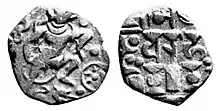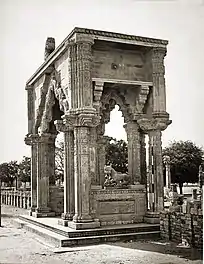Mihira Bhoja
Mihira Bhoja (c. 836–885 CE) or Bhoja I was a king belonging to the Gurjara-Pratihara Dynasty. He succeeded his father Ramabhadra. Bhoja was a devotee of Vishnu and adopted the title of Ādivarāha which is inscribed on some of his coins.[1] One of the outstanding political figures of India in ninth century, he ranks with Dhruva Dharavarsha and Dharmapala as a great general and empire builder.[2]
| Mihira Bhoja | |
|---|---|
| Adivaraha | |
| 6th Gurjara-Pratihara king | |
| Reign | c. 836 – c. 885 CE |
| Predecessor | Ramabhadra |
| Successor | Mahendrapala I |
| Died | 885 Narmada River |
| Issue | Mahendrapala I |
| Father | Ramabhadra |
| Religion | Hinduism |

At its height, Bhoja's empire extended to Narmada River in the South, Sutlej River in the northwest, and up to Bengal in the east. It extended over a large area from the foot of the Himalayas up to the river Narmada and included the present district of Etawah in Uttar Pradesh.[3][4]
Reign
During his reign, the capital was in Kannauj (present-day Uttar Pradesh), during his period Kannauj was referred as Panchala.
He was a bitter enemy of the Arab invaders[2] who, according to an Arab chronicler, Sulaiman, maintained a large army and had a fine cavalry.[2]
He was succeeded by his son Mahendrapala I (c.836 - 910 CE).
Military career
Mihira Bhoja first consolidated his territories by crushing the rebellious feudatories in Rajasthan, before turning his attention against the old enemies the Palas and Rastrakutas.[9] The Palas of Bengal, ruled by King Devapala (c. 810–850), were reputed to have
Eradicated the race of the Utkalas, humbled the pride of the Hunas and scattered the conceit of the Dravidas and Pratiharas."-Badal Inscription.
When Mihira Bhoja started his career reverses and defeats suffered by his father Ramabhadra had considerably lowered the prestige of the Royal family. He invaded the Pala Empire of Bengal, but was defeated by Devapala
He then launched a campaign to conquer the territories to the south of his empire and was successful, Malwa, Deccan and Gujarat were conquered. In Gujarat he Stepped into a war of succession for the throne of Gujarat between Dhruva II of the Gujarat Rashtrakuta dynasty and his younger brother, Bhoja led a cavalry raid into Gujarat against the Dhruva while supporting his Dhruva's younger brother. Although the raid was repulsed by Dhruva II. Bhoja was able to retain dominion over parts of Gujarat and Malwa.[9]
The Pratiharas were defeated in large battle in Ujjain by Rastrakutas of Gujarat however, retribution followed on the part of the Pratiharas,by the end of his reign, Bhoja had successfully destroyed the Gujarat Rashtrakuta dynasty.[10]: 20–21
Bhoja's feudatory, the Guhilas chief named Harsha of Chatsu, is described as :
“defeating the northern rulers with the help of the mighty elephant force”, and “loyally presenting to Bhoja the special ‘Shrivamsha’ breed of horses, which could easily cross seas of sand."[9] He gradually rebuilt the empire by conquest of territories in Rajputana, Gujarat and Madhya Pradesh[2]
Besides being a conqueror, Bhoja was a great diplomat.[2]
The Kingdoms which were conquered and acknowledged his suzerainty includes Travani, Valla, Mada, Arya, Gujaratra,Lata Parvarta and Chandelas of Bundelkhand. Bhoja's Daulatpura-Dausa Inscription(AD 843), confirms his rule in Dausa region. Another inscription states that,"Bhoja's territories extended to the east of the Sutlej river."
Kalhana's Rajatarangini states that the territories of Bhoja extended to Kashmir in the north, and bhoja had conquered Punjab by defeating ruling ‘Thakkiyaka’ dynasty .[9][11]
After Devapala's death, Bhoja defeated the Pala King Narayanapala and expanded his boundaries eastward into Pala-held territories near Gorakhpur.
Hudud-ul-Alam a tenth century Persian geographic text states that most of the kings of India acknowledged the supremacy of the powerful ‘Rai of Qinnauj’, (Kannauj was the capital of the Imperial Pratiharas) whose mighty army had 150,000 strong cavalry and 800 war elephants.[9]
His son Mahenderpal I (890–910), expanded further eastwards in Magadha, Bengal, and Assam.
Coins of Mihira Bhoja

Mihira Bhoja's epithet was Srimad-Adivaraha (the fortunate primeval boar incarnation of Vishnu) and therefore there is a broad agreement amongst the scholars on the attribution of adivaraha dramma billon coins to him. These coins have a depiction of Adivaraha on the obverse.[14] On the obverse along with the God Adivaraha, in his right there is a solar wheel with spokes and in the left are other emblems such as mace, lotus flower and conch-shell. Under the feet of the God is probably a two-headed serpent.[15]
According to Alexander Cunningham these types of coins are only found in silver and copper. It is suggested that Copper coins were originally coated with silver to circulate as silver coins.[15]
Adivarah coins were noted by Thakkar pheru in 13th century text Dravya-Pariksha who was mint master under Alauddin khilji.[9]
Notes
- Satish Chandra, National Council of Educational Research and Training (India) (1978). Medieval India: a textbook for classes XI-XII, Part 1. National Council of Educational Research and Training. p. 9.
- Radhey Shyam Chaurasia (2002). History of Ancient India: Earliest Times to 1000 A. D. Atlantic Publishers & Distributors. p. 207. ISBN 978-81-269-0027-5.
He was undoubtedly one of the outstanding political figures of India in ninth century and ranks with Dhruva and Dharmapala as a great general and empire builder.
- E-gazeteer-History of Etawah district
- Digital South Asia Library
- K. D. Bajpai (2006). History of Gopāchala. Bharatiya Jnanpith. p. 31. ISBN 978-81-263-1155-2.
- Jain, Kailash Chand (31 December 1972). Malwa Through The Ages. Motilal Banarsidass Publ. pp. 429–430. ISBN 978-81-208-0824-9.
- Rajan, K. V. Soundara (1984). Early Kalinga Art and Architecture. Sundeep. p. 103.
When we have to compare a khākhärä temple of Kalinga with anything outside its borders , the most logical analogue coming to our mind will be that of Teli ka Mandir at Gwalior of the time of Pratihara Mihira Bhoja.
- Sharma, Dr Shiv (2008). India - A Travel Guide. Diamond Pocket Books (P) Ltd. p. 531. ISBN 978-81-284-0067-4.
- Hooja, Rima (2006). A History of Rajasthan. Rajasthan: Rupa & Company. pp. 277–280. ISBN 8129108909.
- Sen, S.N., 2013, A Textbook of Medieval Indian History, Delhi: Primus Books, ISBN 9789380607344
- Dasharatha Sharma, Rajasthan Through the Ages "a comprehensive and authentic history of Rajasthan" Bikaner , Rajasthan State Archives 1966, pp.144-54
- Smith, Vincent Arthur; Edwardes, S. M. (Stephen Meredyth) (1924). The early history of India : from 600 B.C. to the Muhammadan conquest, including the invasion of Alexander the Great. Oxford : Clarendon Press. p. Plate 2.
- Ray, Himanshu Prabha (2019). Negotiating Cultural Identity: Landscapes in Early Medieval South Asian History. Taylor & Francis. p. 164. ISBN 9781000227932.
- Deyell 1999, pp. 28–29
- Puri, Baij Nath (1986). The History of the Gurjara-Pratihāras. New Delhi: Munshiram Manoharlal Publishers. pp. 229–231.
References
- Deyell, John S. (1999), Living without Silver, Oxford University Press, New Delhi, ISBN 0-19-564983-4
.jpg.webp)
